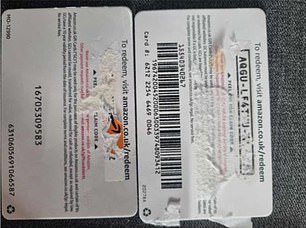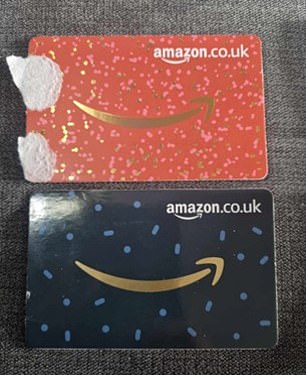Shoppers are being warned about a new ‘gift voucher’ scam imported from the US, with criminals taking money out of vouchers before the recipient has a chance to spend it.
This is Money was alerted to the scam’s presence in Britain when reader Lorraine* (not her real name) contacted us to say her family had been victimized.
Lorraine bought two Amazon gift cards worth a total of £150 from her local Sainsbury’s store in early December.
A few weeks later she sent them as a Christmas present to her niece in another part of the country – one from Lorraine herself, and one to give on behalf of her elderly mother.

Confused: When the person who received the gift card went to Amazon’s website to redeem it, she was stunned to find that the money had already been spent (stock image, posed by model)
But when her niece Laura* tried to spend the money on Amazon’s website in January, the money was already gone.
She had become suspicious when she tried to remove the plastic card from the paper backing and discovered that it had been stuck on, making the code needed to validate the voucher online invisible.
She called Amazon to ask if the money could be credited to their online account using the voucher’s serial number, but Amazon said the money on the cards had already been spent in mid-December – before Laura had even received them.
It’s part of a scheme known as the gift card scam, which became widespread in the US around Christmas 2023.
The trick begins when thieves steal the cards, which are often left hanging at the ends of supermarket shelves, sometimes swiping hundreds of them at a time.
Then they take them away, scratch off the silver foil that hides the validation code and copy the numbers.
The card is stuck back on the paper packaging, so as not to arouse suspicion. Alternatively, thieves can purchase silver foil stickers online that make the card appear unused.
The cards are then routed back to the store they were taken from.
Gift cards are worthless when they’re on the shelves, and are only replenished with cash when someone like Lorraine picks them up and takes them to the checkout.


Stuck: The gift cards were taped to the packaging so shoppers couldn’t check the codes and see that they were unreadable


Used up: It turned out that the money preloaded on the cards had already been spent by scammers
But once they are full of cash, the criminals take advantage of the fact that it usually takes days, weeks and even months for the voucher to be issued.
Armed with the validation codes, they want to get there first, which means the confused recipient is left with nothing.
They will regularly check to see if any money has been loaded, and the number of stolen cards will mean that at least some are likely to pay off.
It is not exclusive to Amazon vouchers or to Sainsbury’s supermarkets, and This is Money understands other major retailers are being targeted.
This works particularly well around Christmas as the fraudsters can trust that recipients will not attempt to spend the money until at least December 25th. However, it can happen at any time of the year.
There will also likely be people who have unused holiday vouchers and may not realize they have been used up.
An Amazon spokesperson said: ‘We take gift card fraud very seriously.
“We are working closely with our third-party distributors to improve the way we protect customers and businesses.
‘If customers are concerned about a gift card, they should return it to the place of purchase.
‘We also encourage customers to report suspected scams to us so we can protect customers.’
Before purchasing a gift card, customers should carefully check for signs of tampering – and make sure they keep the receipt.
When Lorraine contacted This is Money about her gift cards, she said Amazon had already told her it could not give her a refund.
Laura had not been able to get a refund at her local store because she did not have the receipt.
However, she had returned the defaced cards to Lorraine so she could try to return them to the store where she bought them in December.
Ultimately, Lorraine still managed to get a refund from Sainsbury’s for the value of £150, partly in cash and partly in Sainsbury’s vouchers.
But she suspects she’s not the only one caught out.
“I find it hard to believe that I am the unluckiest person in Britain and have managed to take the only two cards that have been tampered with,” she said.
A spokesperson for Sainsbury’s said: ‘We have told the customer how sorry we are for their experience and have arranged a full refund.
‘We have a range of measures in place to prevent fraud and we are working closely with the Gift Card and Voucher Association to see what else retailers can do to help.’
